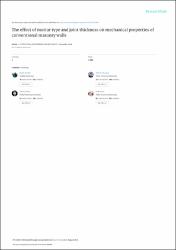| dc.contributor.author | Zengin, Başak | |
| dc.contributor.author | Toydemir, Burak | |
| dc.contributor.author | Ulukaya, Serhan | |
| dc.contributor.author | Oktay, Didem | |
| dc.contributor.author | Yüzer, Nabi | |
| dc.contributor.author | Koçak, Ali | |
| dc.date.accessioned | 2024-03-19T00:00:57Z | |
| dc.date.available | 2024-03-19T00:00:57Z | |
| dc.date.issued | 2018 | en_US |
| dc.identifier.issn | 1225-4568 | |
| dc.identifier.issn | 1598-6217 | |
| dc.identifier.uri | https://hdl.handle.net/11363/7221 | |
| dc.description.abstract | Masonry walls are of a complex (anisotropic) structure in terms of their mechanical properties. The mechanical
properties of the walls are affected by the properties of the materials used in wall construction, joint thickness and the type of
masonry bond. The carried-out studies, particularly in the seismic zones, have revealed that the most of the conventional
masonry walls were constructed without considering any engineering approach. Along with that, large-scale damages were
detected on such structural elements after major earthquake(s), and such damages were commonly occurred at the brick-joint
interfaces. The aim of this study was to investigate the effect of joint thickness and also type of mortar on the mechanical
behavior of the masonry walls. For this aim, the brick masonry walls were constructed through examination of both the literature
and the conventional masonry walls. In the construction process, a single-type of brick was combined with two different types of
mortar: cement mortar and hydraulic lime mortar. Three different joint thicknesses were used for each mortar type; thus, a total
of six masonry walls were constructed in the laboratory. The mechanical properties of brick and mortars, and also of the
constructed walls were determined. As a conclusion, it can be stated that the failure mechanism of the brick masonry walls
differed due to the mechanical properties of the mortars. The use of bed joint thickness not less than 20 mm is recommended in
construction of conventional masonry walls in order to maintain the act of brick in conjunction with mortar under load. | en_US |
| dc.language.iso | eng | en_US |
| dc.publisher | TECHNO-PRESS, PO BOX 33, YUSEONG, DAEJEON 305-600, SOUTH KOREA | en_US |
| dc.relation.isversionof | 10.12989/sem.2018.67.6.579 | en_US |
| dc.rights | info:eu-repo/semantics/openAccess | en_US |
| dc.subject | masonry wall | en_US |
| dc.subject | mortar | en_US |
| dc.subject | joint thickness | en_US |
| dc.subject | mechanical behaviour | en_US |
| dc.title | The effect of mortar type and joint thickness on mechanical properties of conventional masonry walls | en_US |
| dc.type | article | en_US |
| dc.relation.ispartof | STRUCTURAL ENGINEERING AND MECHANICS | en_US |
| dc.department | Mühendislik ve Mimarlık Fakültesi | en_US |
| dc.authorid | https://orcid.org/0000-0002-7592-3446 | en_US |
| dc.identifier.volume | 67 | en_US |
| dc.identifier.issue | 6 | en_US |
| dc.identifier.startpage | 579 | en_US |
| dc.identifier.endpage | 585 | en_US |
| dc.relation.publicationcategory | Makale - Ulusal Hakemli Dergi - Kurum Öğretim Elemanı | en_US |
| dc.contributor.institutionauthor | Toydemir, Burak | |

















